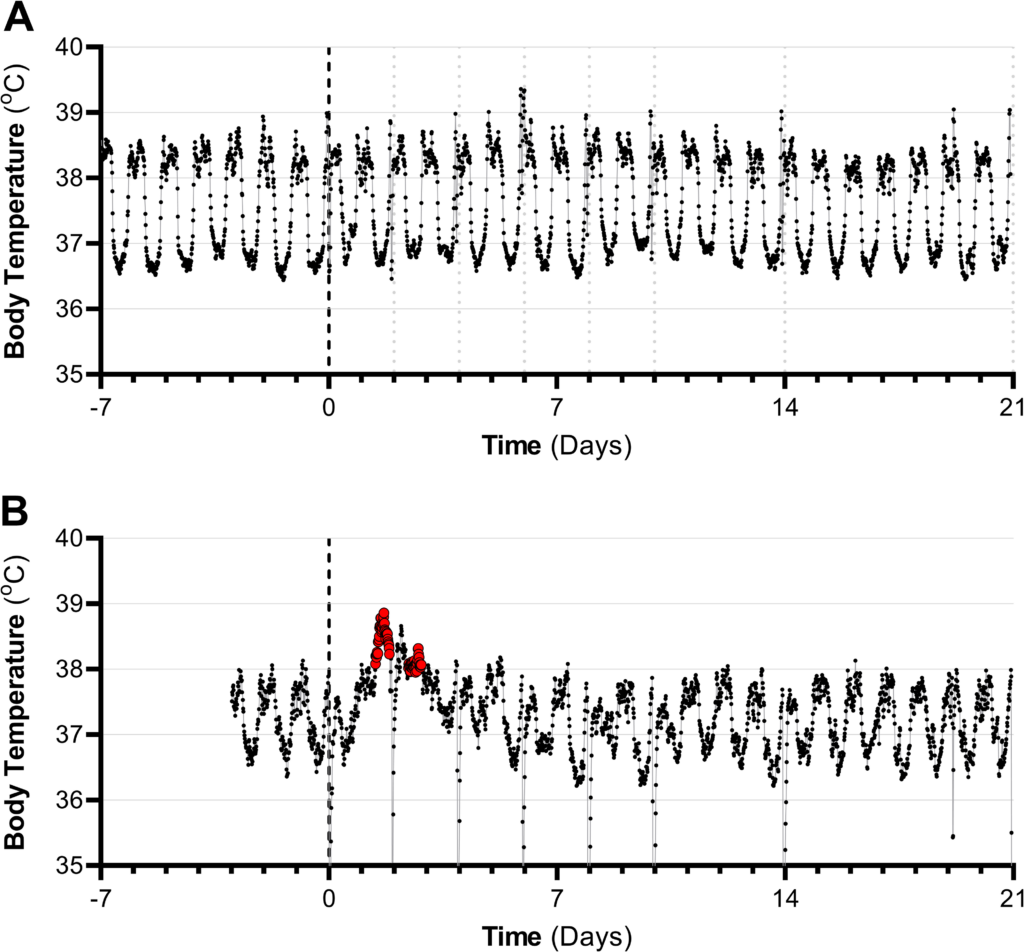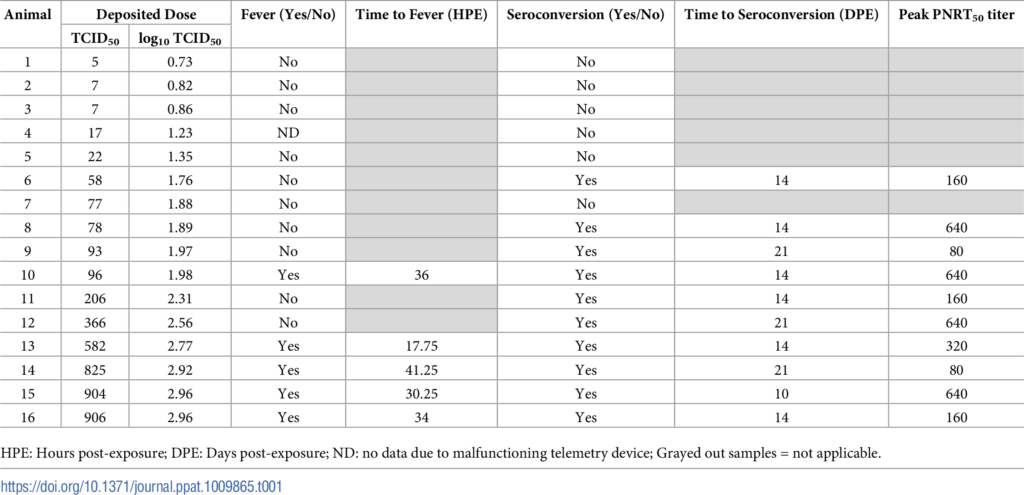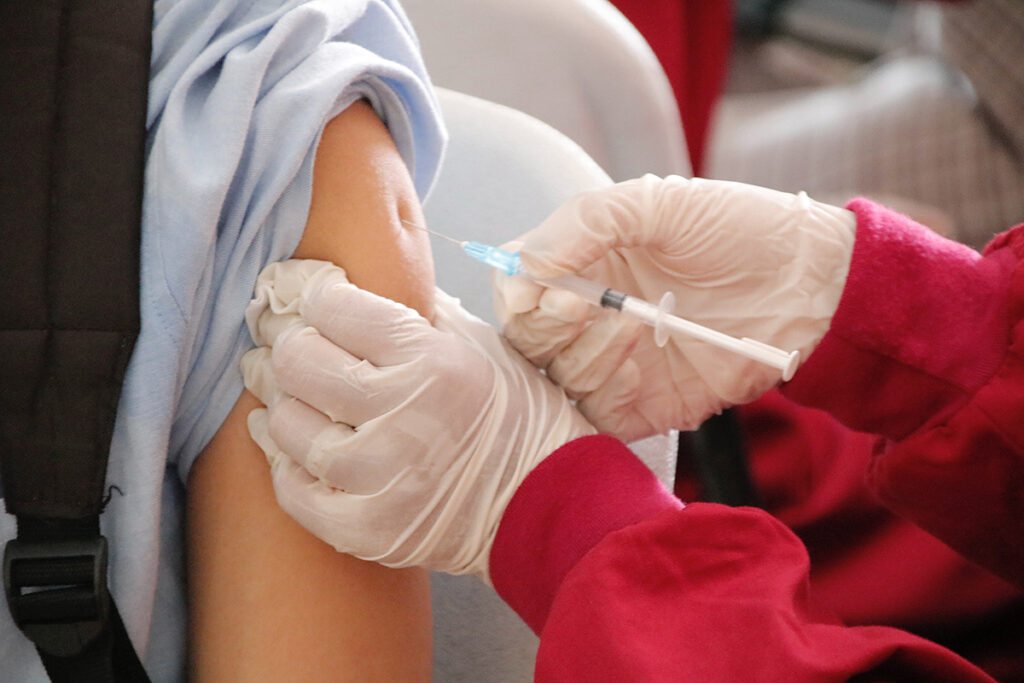One of the ways of transmission of COVID-19 is the inhalation of aerosols infected with SARS-CoV-2. An infected person releases such aerosols when breathing, coughing, talking, and singing.
Aerosol particles containing SARS-CoV-2 are less than 5 microns in diameter. These particles are dangerous because they can remain in the air for a long time and remain infectious. Several studies in primates have shown that when exposed to aerosols with an aerodynamic diameter of fewer than 5 microns containing SARS-CoV-2, primates develop a disease similar to COVID-19 in humans. This fact confirms that the coronavirus can be transmitted through aerosols released from the respiratory tract.
Scientists at the National Center for Biosecurity and Response Analysis in the United States investigated how the infectious dose is related to the symptoms of COVID-19. Scientists used aerosols with small particles containing SARS-CoV-2, with an aerodynamic diameter of fewer than 5 microns – just such are released when breathing or talking. The study was carried out on macaques.
Antibody Production: Higher Infectious Dose, Stronger Seroconversion
By the end of the 21-day observation period, 10 of 16 monkeys had developed antibodies. The antibody level depended on the infecting dose (Fig. 1). Neutralizing antibodies were present in all seroconverted animals. Peak titers ranged from 80 to 640. Peak neutralizing titers did not correlate with the challenge dose. There was no strong association between the infecting amount and the time to antibody production.
Figure 1. Dose-response relationship for fever and seroconversion
Image source: https://journals.plos.org/plospathogens/article/figure?id=10.1371/journal.ppat.1009865.g001
Temperature with COVID-19 Depends on The Infectious Dose
Of the 16 monkeys, 5 of the 16 monkeys experienced periodic increases in body temperature of more than 1 ° C from baseline for more than 2 hours. The presence of fever depended on the infecting dose (Fig. 1).
The median time to fever onset was 34 hours (range 18 to 41 hours). Typical temperature profiles for two animals, both of which seroconverted but only one had a fever, are shown in Figure 2.
The most prolonged duration of continuous fever is 2.5 to 13 hours. One macaque had one continuous period of fever. The other 4 macaques have several distinct periods of fever. There was no strong association between the infectious dose and the time to the onset of the fever, the longest duration of the fever, and the number of periods of fever.
The mean infectious dose for seroconversion was significantly lower than for fever.
Figure 2. Temperature profiles
The top graph is the temperature profile for an animal that received a lower dose of the virus and did not develop a fever but seroconverted 14 days after exposure to SARS-CoV-2.
The bottom graph is the temperature profile of an animal that received a high dose of the virus and developed fever and seroconversion 14 days after exposure to SARS-CoV-2.
Red circles – are the periods of fever when body temperature exceeds baseline by more than 1 ° C for more than two hours.
The dark vertical dashed line on day 0 is exposed to SARS-CoV-2.
Image source: https://journals.plos.org/plospathogens/article/figure?id=10.1371/journal.ppat.1009865.g002
Fever and Antibody Production is Physiologically Related
Scientists analyzed the results of fever and seroconversion in 16 animals:
Image source: https://journals.plos.org/plospathogens/article/figure?id=10.1371/journal.ppat.1009865.t001
Simulations have shown that fever is dose-dependent and is due to seroconversion. Higher doses are needed to trigger febrile seroconversion than seroconversion alone. Fever alone is rare.
How Manifestations of COVID-19 Affect Laboratory Parameters
To compare virus isolation, cytokine levels, hematology, serum chemistry, and blood coagulation parameters, animals were grouped according to disease manifestations:
- 5 macaques with fever and seroconversion;
- 5 monkeys with seroconversion but no fever;
- 6 monkeys without seroconversion and no fever.
Virus Isolation
8 out of 10 seroconverted monkeys, including all 5 febrile monkeys, shed the virus.
Low viral RNA levels were also found in 2 out of 6 monkeys without seroconversion. The proportion of macaques shedding the virus was the same in the febrile and febrile groups. Both rates were significantly higher than the proportion observed in the no seroconversion and no fever group.
Virus/viral RNA was detected in nasopharyngeal and oropharyngeal swabs as early as 2 days after exposure to SARS-CoV-2 and 10/21 days after exposure.
Cytokine levels
In the seroconverted and febrile group, post-exposure IL-6 levels temporarily but significantly increased on day 2 from baseline. In two macaques in this group, IL-6 levels reached levels reported for severe cases of COVID-19 in humans. By day 4 post-exposure, IL-6 levels returned to baseline values.
IL-8 levels did not change significantly.
The levels of other cytokines (IL-10, IL-2, IL-1β, and IFN-γ) were below the detection limit.
The ratio of neutrophils: lymphocytes
Studies have shown that patients with more severe COVID-19 have an increased neutrophil: lymphocyte ratio. However, there was no significant change from baseline in the present research in any of the groups.
Blood clotting
Blood clotting disorders have been reported in patients with COVID-19: elevated D-dimer levels, prolonged prothrombin time (PT), lengthy activated partial thromboplastin time (APTT), and mild thrombocytopenia.
There was no significant increase from baseline for either PT or APTT in either group in the present study. However, a small but significant decrease in PT was observed in several groups. Similarly, a small but significant reduction in APTT from baseline was observed 4 days after exposure in the group without seroconversion and fever.
Changes in kidney function
Impaired renal function is associated with severe COVID-19 in humans. Indicators that show renal disorders: elevated blood urea levels (BUN), creatinine (CREA), BUN: CRE ratio.
In the present study, there was no significant increase from baseline for BUN, CRE, and BUN: CRE ratio in any group. However, there was a slight but significant decrease in BUN and BUN: CRE.
Body mass
No significant changes in body weight were observed during the first 10 days after exposure in any group. In addition, no respiratory signs of illness or changes in activity were noted during the twice-daily observations.
Conclusions
The likelihood of infection depends on the dose of SARS-CoV-2. Antibody production and fever are also dose-dependent, with the mean dose for seroconversion being significantly lower than for fever.
Infected animals without signs of disease shed the virus and can be infectious, consistent with reports of the asymptomatic spread of COVID-19.
In asymptomatic macaques with seroconversion and neutralizing antibody titers, the virus was detected in swabs from the nasopharynx and oropharynx for 21 days. It suggests that animals without apparent signs of disease may be infectious. Similarly, patients with mild or asymptomatic illness showed viral RNA in nasopharyngeal or oropharyngeal swabs within 6-37 days, including several positives after a previous negative one.
The dose of SARS-CoV-2 affects the manifestation of the disease. Therefore, it is essential to adhere to public health measures that limit the amount of the virus. Among them: social distancing, wearing masks, and enhanced ventilation.
Useful article, necessary information? Share it!
Someone will also find it useful and necessary:
Source
Seroconversion and fever are dose-dependent in a nonhuman primate model of inhalational COVID-19






